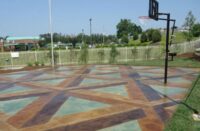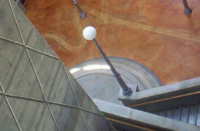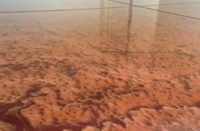
Question: In our home in Houston, we have a stained concrete slab-on-grade floor covered with white powder. We had the floor tested and the white powder was identified as salts escaping and clouding the floor. During the three years we’ve lived in the house, our builder has tried various things to fix the floor. First, he tried redoing the stain and sealer, but the same discoloration happened. Recently, the builder removed the sealer and waxed the floor to allow it to breathe and the salts to rise through the floor. The salts are now easily wiped away, but the wax is wearing off and sticking to our socks, shoes and dog’s paws. Can anything be done to salvage the floor? We have thought about tiling over it, but want to know if any special preparations are necessary.
Since you have had this issue for three years, it sounds like you have a chronic and ongoing efflorescence problem. Efflorescence is salt deposited on surface concrete and masonry. It is created when water carries free salts out of concrete or masonry and they react with the atmosphere, producing insoluble salts typically white in appearance.
Water is the trigger that makes efflorescence happen. Do you have a high water table, flood plain or other situation that’s causing water to get under your concrete foundation? Anything you can do to minimize water migration under your concrete will help. This would include installing French drains or possibly regrading the slope of your property to carry water away from the foundation. The fact that you live in a coastal area does not help, as the water table is probably high, along with the salt content in the soil and water.
Efflorescence will not only cause problems with a stained and sealed concrete floor, it can also delaminate tile and warp wood floors. The best approach would be to strip the sealer from a small area and perform a moisture test — either a calcium chloride moisture test or an electronic surface moisture test — so you can get an idea of how much moisture is in the slab.
The calcium chloride test will show the amount of moisture moving through the top section over a period of time. A simple math calculation provides a rate of moisture movement in pounds per square foot. The electronic surface moisture test will show the amount of moisture on the surface at a given time. The test results will dictate your next step.
If the moisture movement or content is low, a penetrating sealer designed to stop or slow efflorescence can be used. Some of these penetrating sealers can be applied directly over the stain without issue. After the sealer is applied, you can reapply a stain or dye to the floor as needed.
If the moisture movement is high, a more drastic and aggressive topical waterproof coating may have to be used. If you then want to re-stain the floor, you need to apply a polymer-modified cement-based topping to create a new canvas on which to apply the stain. If you want to tile over the floor, the same water mitigation procedures would have to be completed.















